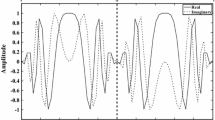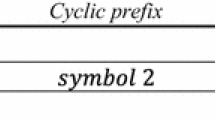Abstract
Generalized frequency division multiplexing (GFDM) is a block-based multicarrier modulation scheme that is a potential candidate for the fifth generation (5G) and beyond wireless communication systems. A critical factor in enhancing the performance of GFDM is achieving precise synchronization. To that end, a new timing synchronization algorithm that utilizes cross-correlation and the sliding window algorithm is presented in this article. The algorithm uses a training symbol based on a chirp sequence. The simulation results of the proposed estimator and conventional CP based approach are analyzed under indoor office scenarios and urban macro cells scenarios for orthogonal frequency division multiplexing and GFDM. The performance of the proposed method is better for GFDM in terms of the three parameters: mean of the timing offset, mean square error of the timing offset, and probability of timing failure. For the proposed algorithm, the results show that the probability of timing failure decreases with increasing signal to noise ratio in the case of the GFDM system.












Similar content being viewed by others
Data Availability
Simulation results were obtained using MATLAB software.
Code Availability
Available on request.
References
Bojadjievski, S., Kalendar, M., & Shuminoski. (2021). T. 5g emerging and mission critical framework with ultra-reliable low delay. Wireless Personal Communications, 119, 2561–2575.
Kim, M., Lee, J., & Park, D. (2020). Iterative detection based on consensus alternating direction method of multipliers in massive machine-type communications. Wireless Personal Communications, 110(4), 2253–2264.
Tripathi, P. S., & Prasad, R. (2018). Spectrum for 5g services. Wireless Personal Communications, 100(2), 539–555.
Zhang, X., Chen, L., Qiu, J., & Abdoli, J. (2016). On the waveform for 5g. IEEE Communications Magazine, 54(11), 74–80.
Lin, H., & Siohan, P. (2016). Major 5g waveform candidates: Overview and comparison. In Signal processing for 5G: Algorithms and implementations (pp. 170–187 ). Wiley.
Parkvall, S., Dahlman, E., Furuskar, A., & Frenne, M. (2017). The new 5g radio access technology. IEEE Communications Standards Magazine, 1(4), 24–30.
Cai, Y., Qin, Z., Cui, F., Li, G. Y., & McCann, J. A. (2017). Modulation and multiple access for 5g network. IEEE Communications Surveys & Tutorials, 20(1), 629–646.
de Almeida, I. B. F., Mendes, L. L., Rodrigues, J. J., & da Cruz, M. A. (2019). 5g waveforms for iot applications. IEEE Communications Surveys & Tutorials, 21(3), 2554–2567.
Mansour Shalaby, E., Ibrahim Hussin, S., & Ibrahim Dessoky, M. (2021). Performance evaluation of 5g modulation techniques. Wireless Personal Communications, 121(4), 2461–2476.
Demir, A. F., Elkourdi, M., Ibrahim, M., & Arslan, H. (2018). Waveform design for 5g and beyond. In 5G networks: Fundamental requirements, enabling technologies, and operations management (pp. 51–76). Wiley.
Michailow, N., Matth e, M., Gaspar, I. S., Caldevilla, A. N., Mendes, L. L., Festag, A., & Fettweis, G. (2014). Generalized frequency division multiplexing for 5th generation cellular networks. IEEE Transactions on Communications, 62(9), 3045–3061.
Gupta, M., Kang, A. S., & Sharma, V. (2020). Comparative study on implementation performance analysis of simulink models of cognitive radio based GFDM and UFMC techniques for 5g wireless communication. Wireless Personal Communications, 126, 1–31.
Fettweis, G., Krondorf, M., & Bittner, S. (2009). GFDM-generalized frequency division multiplexing. In Proceedings of the 69th IEEE VTC Spring, Barcelona, Spain (pp. 1–4).
Gaspar, D., Mendes, L., & Pimenta, T. (2017). GFDM BER under synchronization errors. IEEE Communications Letters, 218, 1743–1746.
Zhang, D., Festag, A., & Fettweis, G. P. (2017). Performance of generalized frequency division multiplexing based physical layer in vehicular communications. IEEE Transactions on Vehicular Technology, 66(11), 9809–9824.
Han, S., Sung, Y., & Lee, Y. H. (2016). Filter design for generalized frequency-division multiplexing. IEEE Transactions on Signal Processing, 65(7), 1644–1659.
Kumar, A., & Magarini, M. (2017). Improving GFDM symbol error rate performance using Better than Nyquist pulse shaping filters. IEEE Latin America Transactions, 15(7), 1244–1249.
Sim, Z. A., Juwono, F. H., Reine, R., Zang, Z., & Gopal, L. (2020). Performance of GFDM systems using quadratic programming pulse shaping filter design. IEEE Access, 8, 37134–37146. https://doi.org/10.1109/ACCESS.2020.2975430
Liu, M., Xue, W., Gao, J., Jia, P., Xu, Y., & Volvenko, S. V. (2022). Prototype filter design for effectively suppressing out-of-band radiation in GFDM systems. IEEE Communications Letters, 27(2), 696–700.
Kalsotra, S., Kumar Singh, A., & Dutt Joshi, H. (2022). Performance analysis of space time coded generalized frequency division multiplexing system over generalized fading channels. Transactions on Emerging Telecommunications Technologies, 33(4), e4423.
Gupta, M., & Gamad, R. (2023). Performance analysis of generalized frequency division multiplexing in various pulse-shaping filter with raised cosine and root raised cosine filter. Wireless Personal Communications, 130, 1–13.
Cheng, H., Xia, Y., Huang, Y., Yang, L., & Mandic, D. P. (2019). Joint channel estimation and Tx/Rx I/Q imbalance compensation for GFDM systems. IEEE Transactions on Wireless Communications, 18(2), 1304–1317.
Mohammadian, A., & Tellambura, C. (2021). Joint channel and phase noise estimation and data detection for GFDM. IEEE Open Journal of the Communications Society, 2, 915–933.
Gaspar, I. S., Mendes, L. L., Michailow, N., & Fettweis, G. (2014). A synchronization technique for generalized frequency division multiplexing. IEEE Transactions on Communications, 2014(1), 1–10.
Gaspar, I., & Fettweis, G. (2015). An embedded midamble synchronization approach for generalized frequency division multiplexing. In 2015 IEEE global communications conference (GLOBECOM), San Diego, USA (pp. 1–5).
Gaspar, I., Festag, A., & Fettweis, G. (2015). Synchronization using a pseudocircular preamble for generalized frequency division multiplexing in vehicular communication. In 2015 IEEE 82nd vehicular technology conference (VTC2015-Fall), Boston, USA (pp. 1–5).
Wang, P.-S., & Lin, D. W. (2016). Maximum-likelihood blind synchronization for GFDM systems. IEEE Signal Processing Letters, 23(6), 790–794.
Na, Z., Zhang, M., Xiong, M., Xia, J., Liu, X., & Lu, W. (2018). Pseudo-noise sequence based synchronization for generalized frequency multiplexing in 5G communication system. IEEE Access, 6, 14812–14819.
Hamid, E. Y., et al. (2022). Joint synchronization and channel equalization of preamble-based GFDM. In 16th international conference on telecommunication systems, services, and applications (TSSA) (pp. 1–6). IEEE, Bali, Indonesia.
Boumard, S., & Mammela, A. (2009). Robust and accurate frequency and timing synchronization using chirp signals. IEEE Transactions on Broadcasting, 55(1), 115–123.
3GPP TR 38.901. (2018). Study on channel model for frequencies from 0.5 to 100 GHz (release 15).
Funding
The authors declare that no funds, grants, or other support were received during the preparation of this manuscript.
Author information
Authors and Affiliations
Contributions
We conducted the research together, analyzed the data, and performed simulations. All authors have approved the final version.
Corresponding author
Ethics declarations
Conflict of interest
The authors declare no conflict of interest.
Additional information
Publisher's Note
Springer Nature remains neutral with regard to jurisdictional claims in published maps and institutional affiliations.
Rights and permissions
Springer Nature or its licensor (e.g. a society or other partner) holds exclusive rights to this article under a publishing agreement with the author(s) or other rightsholder(s); author self-archiving of the accepted manuscript version of this article is solely governed by the terms of such publishing agreement and applicable law.
About this article
Cite this article
Kaur, M., Joshi, H.D. Chirp Signal Based Timing Offset Estimation for GFDM Systems. Wireless Pers Commun 132, 1781–1796 (2023). https://doi.org/10.1007/s11277-023-10679-8
Accepted:
Published:
Issue Date:
DOI: https://doi.org/10.1007/s11277-023-10679-8




